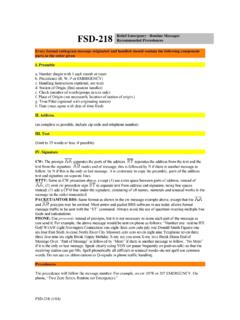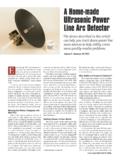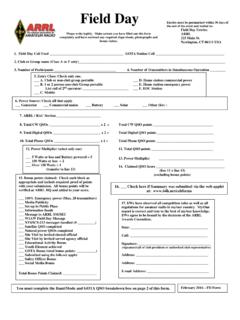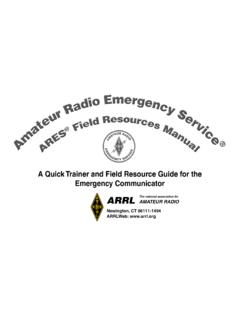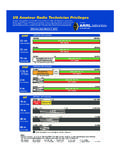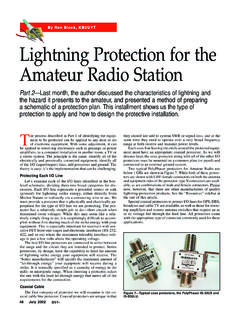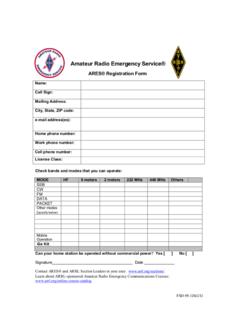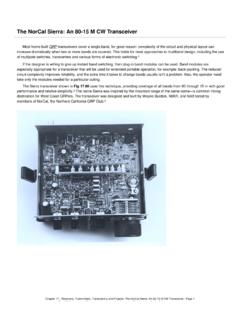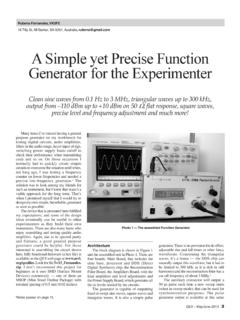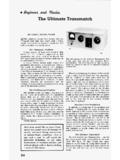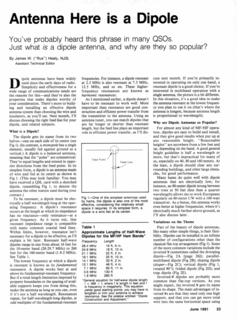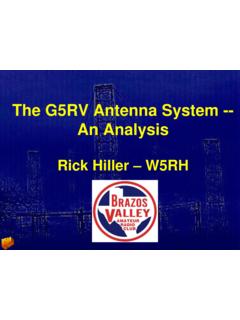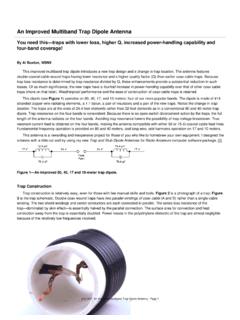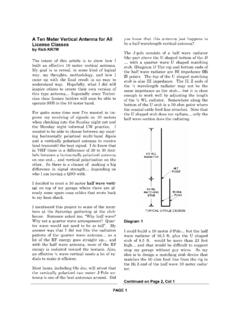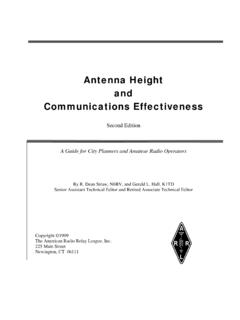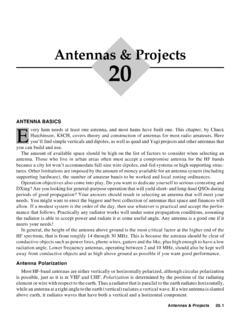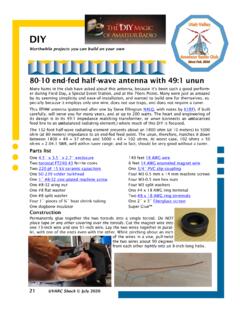Transcription of Build a Homebrew Radio Telescope - ARRL
1 From June 2009 QST ARRLT here are many ham Radio related activ-ities that provide a rich opportunity to explore and learn more about the sci-ence of Radio . One of those opportunities is Radio astronomy. All matter emits Radio frequency (RF) energy dependent on the temperature and makeup of the matter, including the matter in space. The foundation of Radio astronomy is to study the heavens by collecting and analyzing the RF energy that is emitted by bodies in space, very much as optical astronomers use light energy collected by telescopes.
2 It sounds complicated. While professionals use very sophisticated and expensive equipment, you can, with some simple equipment and a little investment, Build a Radio Telescope that will allow you to learn and explore the fundamentals of Radio astronomy. A Homemade Radio TelescopeIn this article, I will Build on an existing design of a Radio Telescope made from one of those ubiquitous TV dish antennas that you see around your neighborhood. The Radio Telescope (RT) project described here can easily be reproduced.
3 Although this is not a fully capable RT, it can provide a wonder-ful learning opportunity for you, or perhaps students in your local 1 shows the Radio Telescope set up. The major components include a modified TV dish antenna mounted on a wooden sup-port structure to allow pointing the antenna , a commercial satellite signal strength detector that displays the signal strength of signals collected by the dish on a meter and an inter-face that converts the signal strength into a amplitude modulated tone. The tone is fed into a computer sound card and finally a computer and software graphically displays the signal strength as a function of time.
4 The TV dish modifications are structural, and any available TV dish system can be used. The signal strength detector costs between $40 and $65 and is widely available from Web retailers. The interface circuit, which will be described shortly, is easily duplicated and costs approximately $20. Finally, the display software is a Homebrew Radio TelescopeExplore the basics of Radio astronomy with this easy to construct Spencer, WA8 SMEF igure 1 Radio Telescope system based on TV dish 2 Dual LNB mount. Note two coax 3 Homemade plastic single LNB mounting bracket.
5 Measure the radiation intensity of the Sun and perhaps detect changes in solar activity. Measure the relative changes in the sur-face temperature of the moon. Learn about and explore a common Radio astronomy collection technique called the drift it Can DoThe following is just a sample of what you can do with this simple RT: Use the sun to study and determine the beamwidth of the dish and verify the mathematic formula that is used to predict dish antenna June 2009 QST arrl Explore the fundamental principle of energy emission as a function of tempera-ture by detecting the relative differences between the temperatures of emitting bodies.
6 Detect satellites parked along the Clarke Belt in geosynchronous orbit and illustrate how crowded space has appear on page 4 Dual coax connector configured LNB. Terminate one connector with a dummy 5 CM satellite signal strength 6 SkyPipe screen showing antenna 7 RT Interface circuit diagram. Detect the Earth s rotation around the Sun and the Earth s spin on its axis by compar-ing daily drift scans of the Subsystem The basic RT system is based on the Itty-Bitty design that is described in two Web ,2 The TV dish is an offset 18 inch dish that has down converter(s) mounted at the focal point of the dish.
7 The down con-verter is called a low noise block (LNB). The LNB is a preamplifier/down converter that converts the satellite signals from around 12 GHz down to around GHz. Most modern dishes have two or more LNBs to access more than one TV satellite at a time without changing the pointing of the dish (Figure 2). The LNBs are mounted to share the focal point of the dish. Since only one LNB is required for the RT, I made a minor adjustment to the published Itty-Bitty design to position the single LNB at the dish focal point.
8 Mounting the single LNB at the focal point really helps in pointing the used the existing LNB housing and mounting bracket as a template to determine the distance between the edge of the mount-ing arm to the mounting hole of the LNB. I then used a piece of plastic to fabricate a new mounting bracket for the LNB as shown From June 2009 QST ARRLto digital converter (ADC). The variable resis-tor in this voltage multiplier circuit is used to calibrate the CM to SkyPipe. The voltage from the multiplier is fed to a programmable interface controller (PIC) that is programmed as a 9-bit ADC to covert the analog voltage that is a function of received signal strength to a 9-bit digital word that is used to control a digitally controlled variable resistor.
9 The interface includes a simple Twin-T audio oscillator circuit that provides a tone of approximately 800 Hz that is fed to the com-puter sound card. The amplitude of this audio oscillator is varied by the digital pot that is being controlled by the PIC. The result is the audio amplitude being varied in step with the signal strength detected by the circuit provides power to the CM and the LNB. A 12 V source in the CM is tapped through an RF choke and this is connected to the LNB coax connector inside the CM (Figure 9).
10 The 12 V is also regulated to 5 V to provide power to the interface. Though prob-ably not required, there are two 5 V sources, one for the digital components of the interface, and the other for the analog components with one common ground point. This arrangement is used to isolate potential digital and analog noise sources within the interface is built on a circuit board and mounted right inside the CM box Figure 8 RT Interface block 9 Power and ground connection to CM 10 CM with interface Figure 3. The dimensions are not super critical, but careful placement certainly will improve the RT LNBs have two coax connec-tors.
